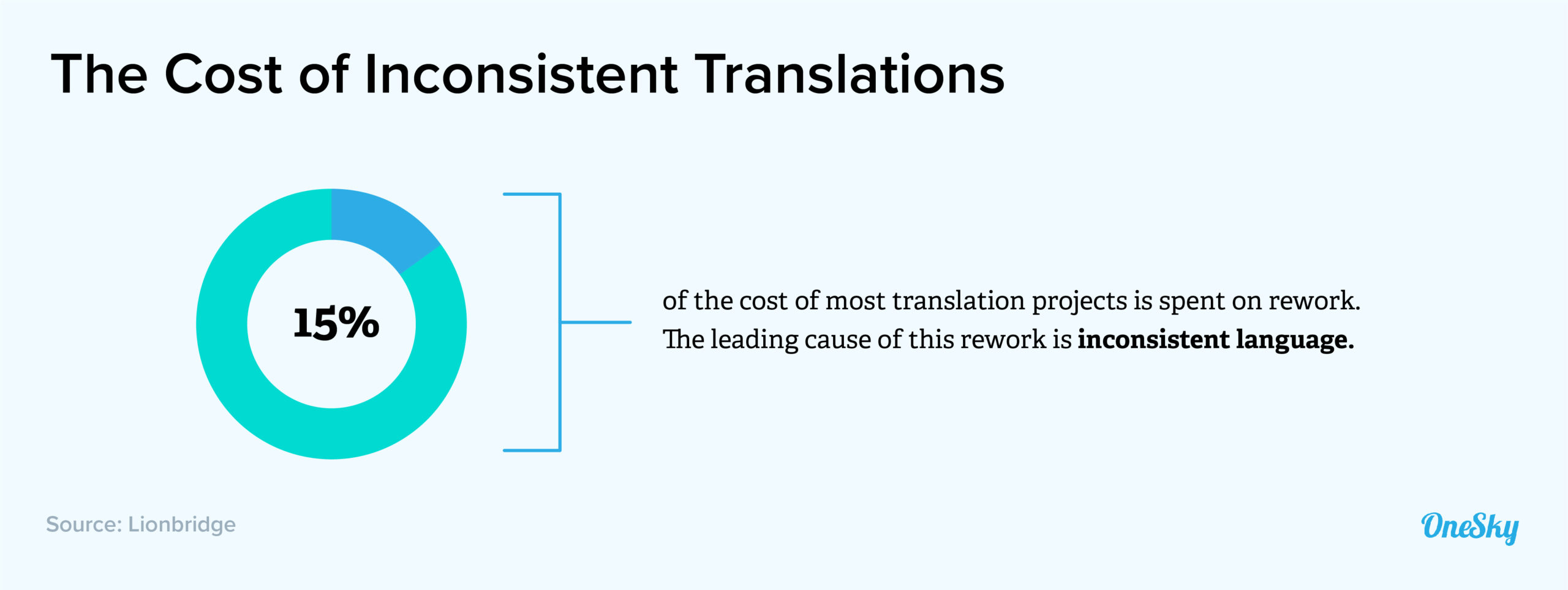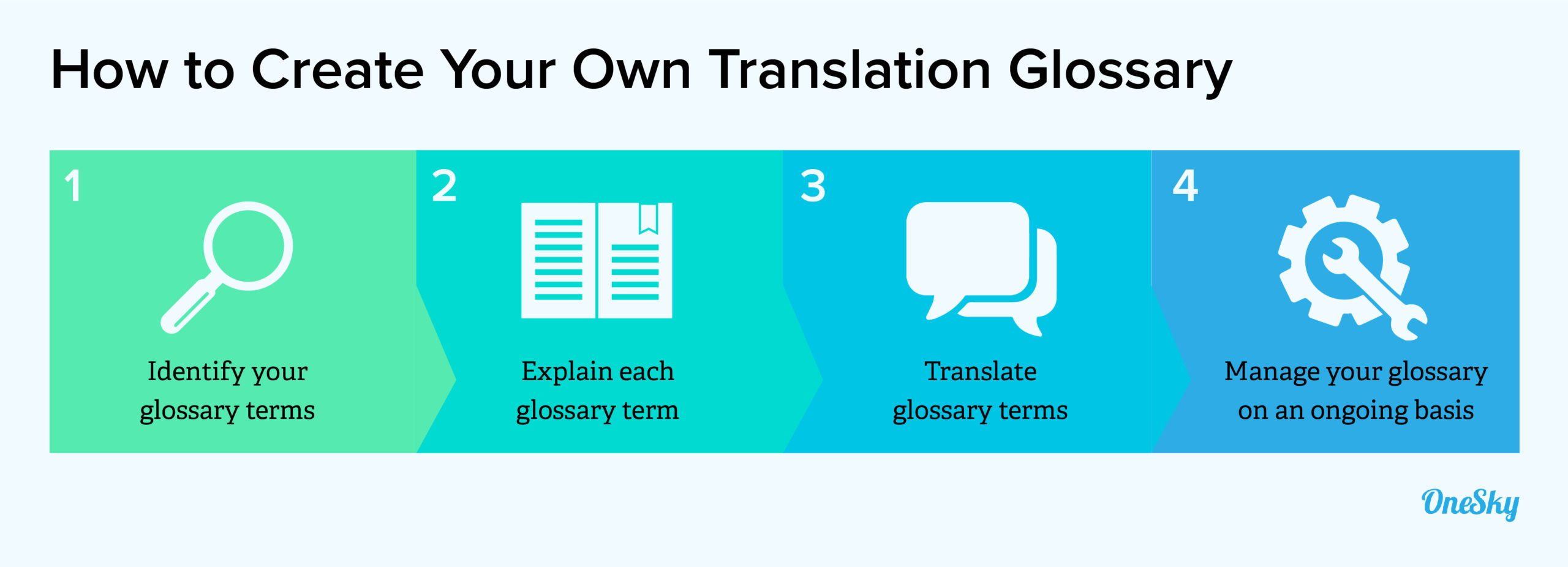The Translation Glossary: How to Improve Your App Localization
In any kind of writing, consistency is paramount.
For example, I’m writing this blog post in a form of casual 21st century American English. If, in the midst of these labors, I did exchange one tongue for another and commenced to write as did the people of Shakespeare’s time, it would be passing strange, forsooth.
See? That’s totally confusing!
A cohesive style, voice, and vocabulary are all key when it comes to creating content that engages and eventually converts readers.
And this is exactly why a translation glossary matters — even more so when you’re translating your content from one language and locale to another. Translators need to know which kind of words to use and which to avoid, which branded terms should be translated and which should remain the same, and so on.
A good translation glossary will get you clear, consistent content and translations. If that’s something your growing business needs, keep reading to learn exactly how to put one together.
What Exactly Is a Translation Glossary?
At its core, a translation glossary is a collection of the key terms that are important to your business in your original language, or source language. It should define how these key terms should be translated — or not translated, as the case may be.
For example, a business like Apple may prefer not to translate the words “iPhone” and “iTunes” no matter what country for which they’re developing new content. So, this is something their translation glossary should definitely denote.
But for terms you do want translated, your translation glossary will provide approved translations in all of your “target languages.”
What Every Translation Glossary Should Include
When you’re creating your translation glossary (which we’ll show you how to do here shortly!), here are some terms we recommend you consider including and defining:
- Terms unique to your brand: This will include things like your brand name, product names, slogans, people’s names, etc.
- Common industry language: These are terms that translators may not recognize or be able to translate correctly without guidance, they’re more common in complex fields like tech and medical
- Unique audience terms: Make sure to define the parameters around language that your audience uses and understands
- Marketing words and phrases: Targeting certain words or phrases in your marketing? Make sure these aren’t changed in translation so your efforts aren’t wasted
- Notes on language you don’t want translated: Note anything else you don’t want touched by translators that hasn’t already been described in your translation glossary
4 Reasons You Should Use a Translation Glossary
Not sure you’re ready to devote the time to developing your own translation glossary?
Well, we think you should.
And not just because we’re kinda obsessed with all things translation at OneSky — but also because it will be a great boost for your brand and your content efforts.
1. To Keep Translations, And Experiences, Consistent
A good translation glossary makes for a consistent translation, and a consistent translation makes for a better user experience.
With a well-defined glossary, a key term won’t change halfway through your website or app, confusing the user and perhaps even pushing them to bounce and engage with a competitor instead.
Take the word “cancel” for example. In Japanese, “cancel” has multiple translations (キャンセル or 取消). If the word “cancel” matters in your app (like on a button), translators need to know which version of the word to use so that they can stick to the correct version throughout and avoid interrupting anyone’s experience.
2. To Ensure That Your Brand Is Recognized Worldwide
Companies live and die on the quality of their brands, especially in today’s global environment.
If users in other countries can’t identify the key terms that define your brand (because, say, translators have rendered them in several different ways), you could be in trouble. A translation glossary helps you maintain brand unity, even as you go global.
3. To Speed up the Translation Process
When translators are confused, they have to ask questions. This slows the process down. A clear translation glossary means that translators have fewer questions for you, which means that they can work much faster. And that enables you to get into new markets and start competing more quickly.
4. To Save on Translation Costs
With a thorough translation glossary full of terms that appear frequently in your app, translators can standardize certain parts of the translation process. This means fewer words for them to handle, which makes the process overall more affordable for your business.

A Step-By-Step Guide to Creating a Translation Glossary
Ready to get started? This guide will get you all the way through creating your first translation glossary.
Step One: Identify Your Translation Glossary Terms
The first step, of course, is to figure out which terms you actually want to include in your translation glossary.
Here are some specific examples of what those terms may include:
- Product/service names
- Brand-specific terminology
- Acronyms
- Standard abbreviations
- Corporate slogans
- Text for user interface buttons
- Any terms that you prefer to keep in your source language
- Terms that are used frequently in your content
- Company-specific jargon
How can you identify which glossary terms should be incorporated?
In the list above, some kinds of terms (such as brand names or slogans) are easy to identify. Others can be trickier to track down among all your content. To identify glossary-ready terms, you can either calculate frequencies or examine your product’s UI.
Calculating Frequencies
In this method, you simply compute the number of times that individual terms appear in your content. Those terms that appear more frequently are usually what you’ll want to include in your glossary.
Pro: It’s easy. You can generate a list of frequencies with a bit of simple programming.
Con: You’ll need to filter some frequently used words — such as “the,” “I,” and “you” — that aren’t specifically related to your product.
Looking at the UI
With this method, you identify the terms that appear anywhere users interact with your website or app. It’s important these terms are translated consistently because they’re how users navigate your product.
Pro: This approach may give you insight into improving your overall user experience.
Con: This process can be a bit time consuming as it can’t really be automated.
For projects that have already been translated into another language, base your translation glossary on the translated material using either segmented files or your translation memory (What’s that? Learn more about translation memory here.).
A word of caution: While you want to have a thorough glossary, remember that more information is not always better. An overstuffed glossary can slow down translators and enhance management costs.
Step Two: Explain Your Translation Glossary Terms
Once you’ve collected all your glossary terms, you’ll need to add in some explanations for your translators.
In order to provide the translators with enough context, you should include the following information about each term:
- Subject (Which feature/area does this word belong to?)
- Part of speech (How is this word being used? As a noun? An adjective? A verb?)
- Definition (What does the word mean?)
- Usage note (How is the word used in the specific context of your app?)
For example, here’s how Facebook explains some of its glossary terms:

Note that Facebook is very clear about how the word will be used within the context of its product. For example, they explain which meaning of the word “fan” is relevant here and what exactly a fan is on Facebook (as opposed to, say, a fan in a soccer stadium).
In some cases, a word may have synonyms within your app, or it may appear in a different form (i.e. with different hyphenation, or in a different tense). Make sure to note any such special cases, so that translators don’t miss out on these related terms.
Step Three: Translate the Glossary Terms
Now you can have your translators do their thing — translate!
Before they totally dive in, work with them to translate your glossary terms into the target language first. This will help make sure you’re happy with the final translation glossary and that it’s consistent throughout.
And just before you finalize the glossary, make sure that every translated term has been approved by an independent in-country reviewer. When disagreements arise among different reviewers, a good rule of thumb is that the clearest, most self-evident translation should be used.
Step Four: Keep Managing Your Translation Glossary
A good translation glossary is, ultimately, a work in progress.
If you have new terms that might benefit from a glossary entry, add them! If your translators often come to you with questions about a particular term, update the glossary. Also, encourage your translators to suggest new terms to add to the glossary.
When you continuously and thoughtfully grow your glossary, you’ll only have an even better glossary ready for translators as your brand expands.

Pro tip: Add a little style to your translation glossary with this guide!
Create a Great Translation Glossary and Beyond with Help from OneSky
The more care you put into the translation process, the better translations you’ll get. A good translation glossary is a key step in creating a clear, consistent, readable translation — which makes for the type of content that powers global businesses.
Have any questions about creating your own translation glossary? Let us know in the comments! And if you’re having any problems kickstarting a translation or localization project, feel free to try out our free consultation service. We’re here to help.
Or if you’re ready to really scale up your cross-country content, we recommend you try out OneSky’s complete translation and localization platform — you can get started today for free!



 Written by -
Written by - 




 Written by
Written by 



Hi Patrick, many companies are using translation agencies nowadays and therefore create translation glossaries. Is anyone selling these glossaries already ?
Great question, Fred. As far as I know, purchasing glossary/terminology is more common in professional fields such as legal and medicine. This is one example: http://www.healthlanguage.com/. At OneSky, we’re also developing glossary-related products. Let me know if you want to stay tuned. 🙂
Hi I’m looking for localization glossaries/dictionaries in Spanish and Portuguese, but I can’t seem to find any. Any ideas?
Thanking a lot of you for sharing the useful information….
Nice information, thanks for sharing